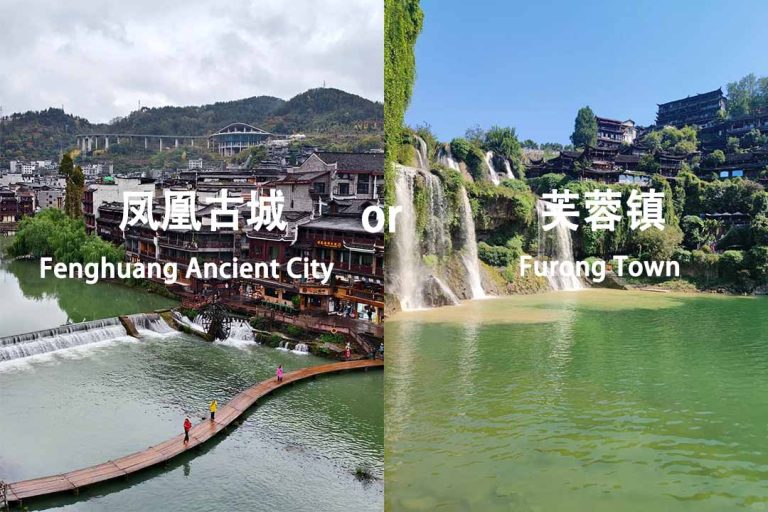When it comes to western Hunan, the first impression of many people may come from Mr. Shen Congwen’s words-the land soaked in the steam of the Tuojiang River and hiding simple human feelings. There are both ”Cuicui grows in the wind and sun, turning the skin black, and the green mountains and green waters are palpable to the eye“, as well as ‘tea’.In this place, the city is built by the water and the mountains. On the side of the mountain, the city wall is like a long snake, crawling away from the mountain”. And if you want to find the source of this poetry, Chadong, located at the junction of Hunan, Guizhou and Chongqing provinces, is an unmissable destination. This is not only the prototype of the story of ‘Border City’, but also the epitome of Western Hunan that Mr. Shen Congwen “frozen” with words. Today, it still retains the appearance of “Lala Crossing”, “Hanging Foot Tower” and “Mill workshop” in the novel, waiting for every traveler to come and unlock the ‘immersive reading of ‘Border City”.”The experience.
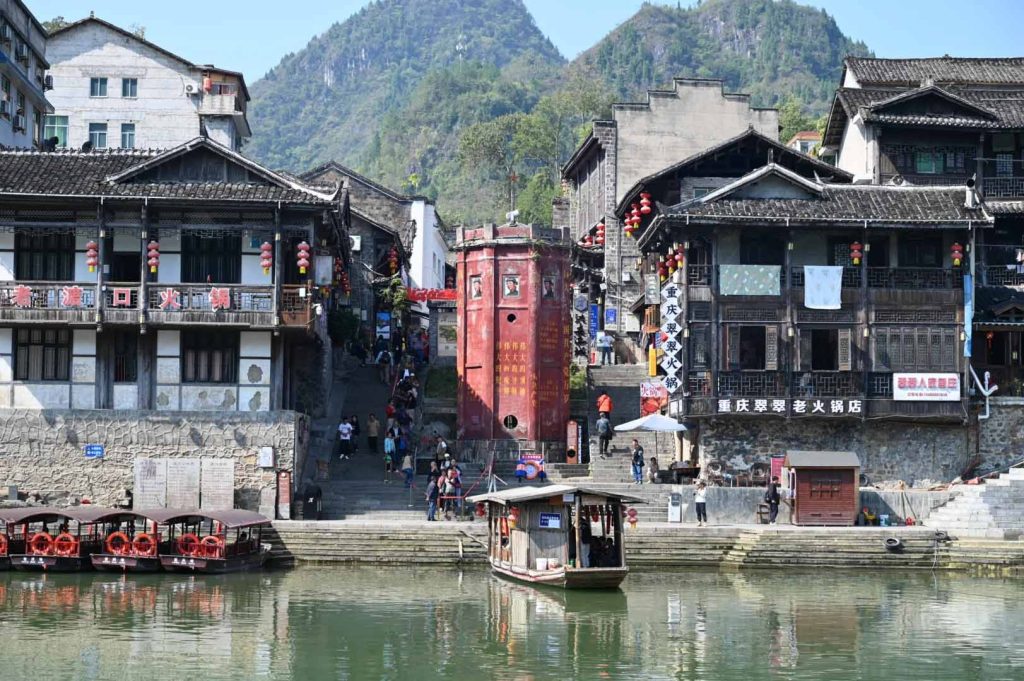
1. Why go to the tea house? ——The indissoluble bond between Shen Congwen and ‘Border City’
In Shen Congwen’s creative career, the tea tree is a special existence. In 1934, he returned home from Beijing and passed through Chadong. He was moved by this small town of “three provinces with one foot’: the Qingshuijiang passed through the town, Chadong in Hunan, Hong’an in Chongqing, and Guiqi in Guizhou were across the river, and the ferry boats were going back and forth on the river, and the ones by the pier.The smell of rice and vegetables wafted out of the hanging foot building, and the old man sat on the stone steps shaking a pu fan… This uncut pyrotechnic aura became the source of inspiration for ‘Border City’.
In the novel, Cuicui and Grandpa guarded the ferry, waiting for their sweetheart among the green mountains and green waters; in reality, the “Lala Crossing” in Cha Dong is still running-there is no paddle, it depends on a steel cable across the river, and the grandfather pulls the rope by hand, and the ferry slowly sails to the other side.The shipping fee of Yuan Qian can make people instantly travel back to the scene of the novel. Standing on the ferry, watching the river shining with sparkling waves, listening to the master humming Xiangxi minor, as if he could see “Cuicui” sitting on the bow of the boat in the next second, his eyes as clear as the river.
For those who like Shen Congwen, Cha Dong is not an ordinary tourist attraction, but the entrance to ‘walk into the ‘Border City”-here, you can find the novel “The White Tower by the stream” and “the mill near the river”, and you can meet the locals who are as simple as “Cuicui”, and more.You can feel the background of Western Hunan in Shen Congwen’s “Human nature is good”.
2. A must-experience in the tea room: re-enacting the poetic scenes in ‘Border City’
1. Take a “Lala Crossing’: feel the ferry time in the novel
“Lala Crossing“ is the symbol of Cha Dong, and it is also the prototype of the ferry ”Cuicui and Grandpa’ in ‘Border City’. Unlike motor boats at other ferry crossings, the lala crossing in Chadong relies on manpower to pull-the master sits on the bow of the boat, clasps the steel cable across the river with both hands, and pulls the boat to the other side step by step. The river flows gently at the bottom of the boat, and the hanging foot building on the shore slowly retreats. The whole process is quiet and healing..
It is recommended to take a boat in the early morning or evening: there is mist floating on the river in the early morning, and the outline of the hanging foot tower looms in the fog, like an ink painting of Danqing; in the evening, the setting sun shines on the river, sparkling, and the green mountains in the distance are dyed golden. At this time, sitting on the bow of the boat, it seems that you can hear Shen Congwen’s pen. “When dusk came, Cuicui was sitting under the white tower behind her house, watching the sky baked into peach-colored thin clouds by the setting sun.’
2. Visiting the ‘Ancient Towns of Border Cities”: Looking for the old buildings in the novel
The ancient town of Chadong is not large. It was built along the Qingshui River. The bluestone road winds and twists. The hanging foot buildings on both sides are surrounded by mountains and rivers. The wooden doors and windows are engraved with simple patterns, and there are red lanterns hanging under the eaves, revealing a quaint atmosphere everywhere. Take a stroll here, it’s easy to find the ‘same scene” in ‘Border City’:
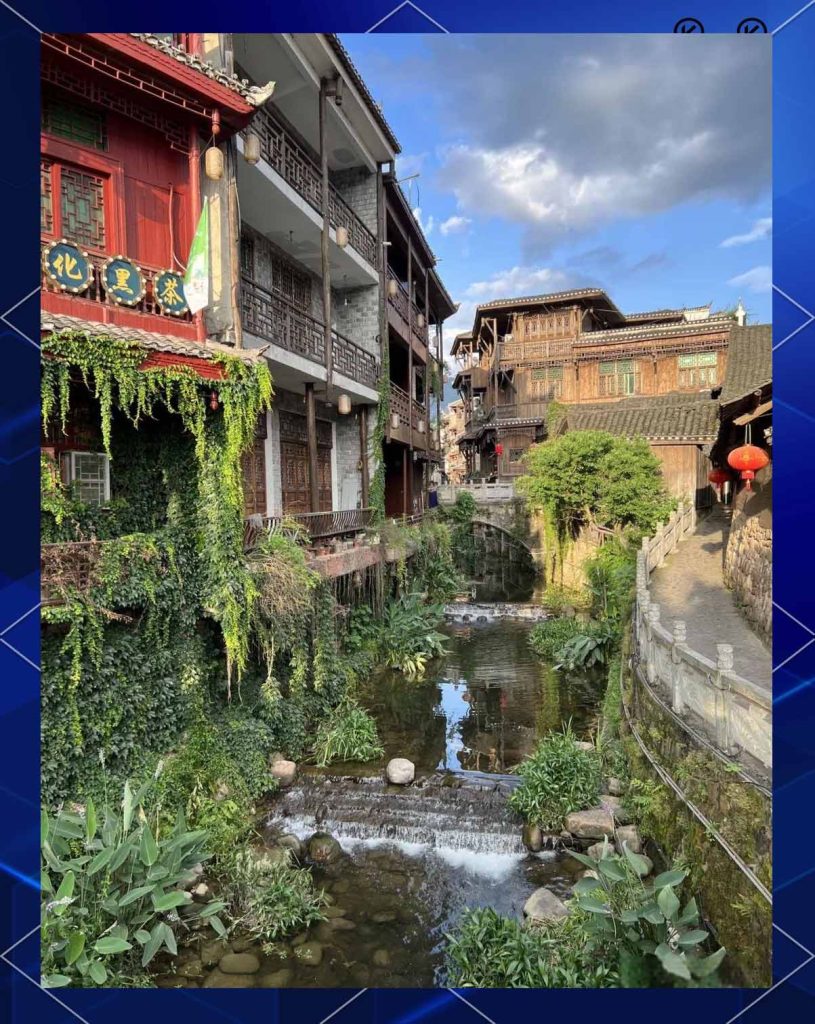
- White Tower: On the top of the mountain next to the ancient town, there is a white tower, which is the prototype of the “white Tower behind Cuicui’s house” in ‘Border City’. Climbing the white Tower, you can overlook the entire panoramic view of Chadong-the Qingshui River passes around the town, the houses in the three provinces are scattered, and the green mountains in the distance are rolling, with an excellent view.
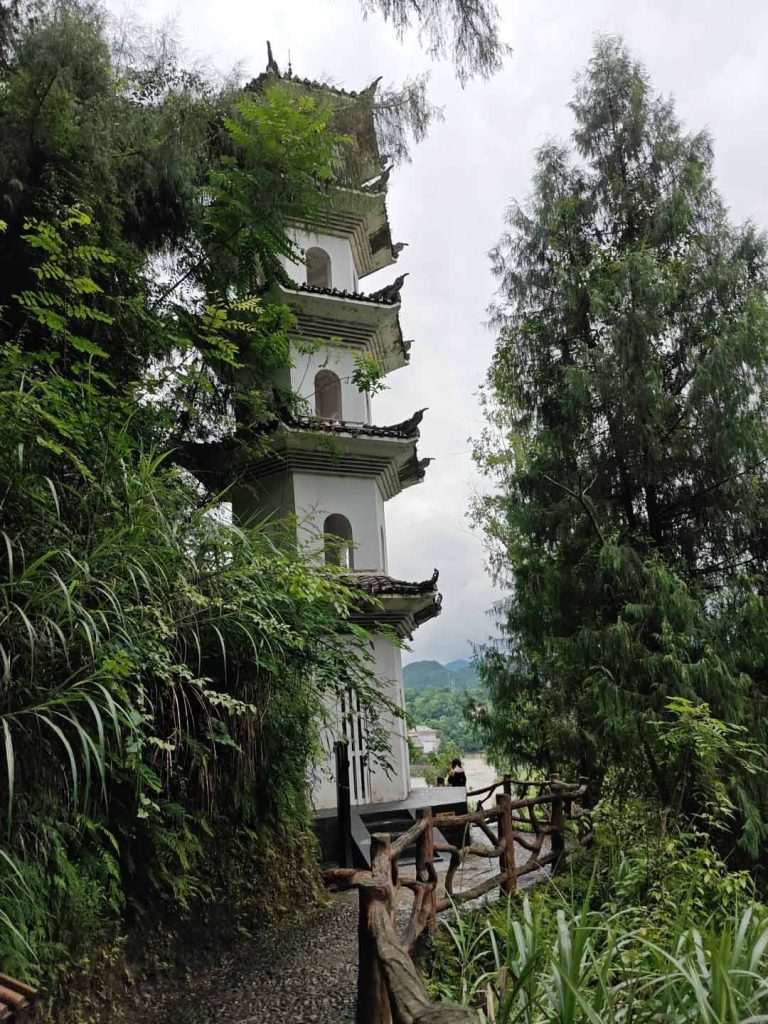
- Mills and mills: In the depths of the ancient town, there are still several old-fashioned mills and mills. The wooden structure is already a bit mottled, but it can still be seen as it was back then. In ‘Border City’, the ”Shunshun Family’s mill“ is a local ”symbol of prosperity’, but now, although these mills are no longer in use, they have become a check-in point for tourists to feel the old days.
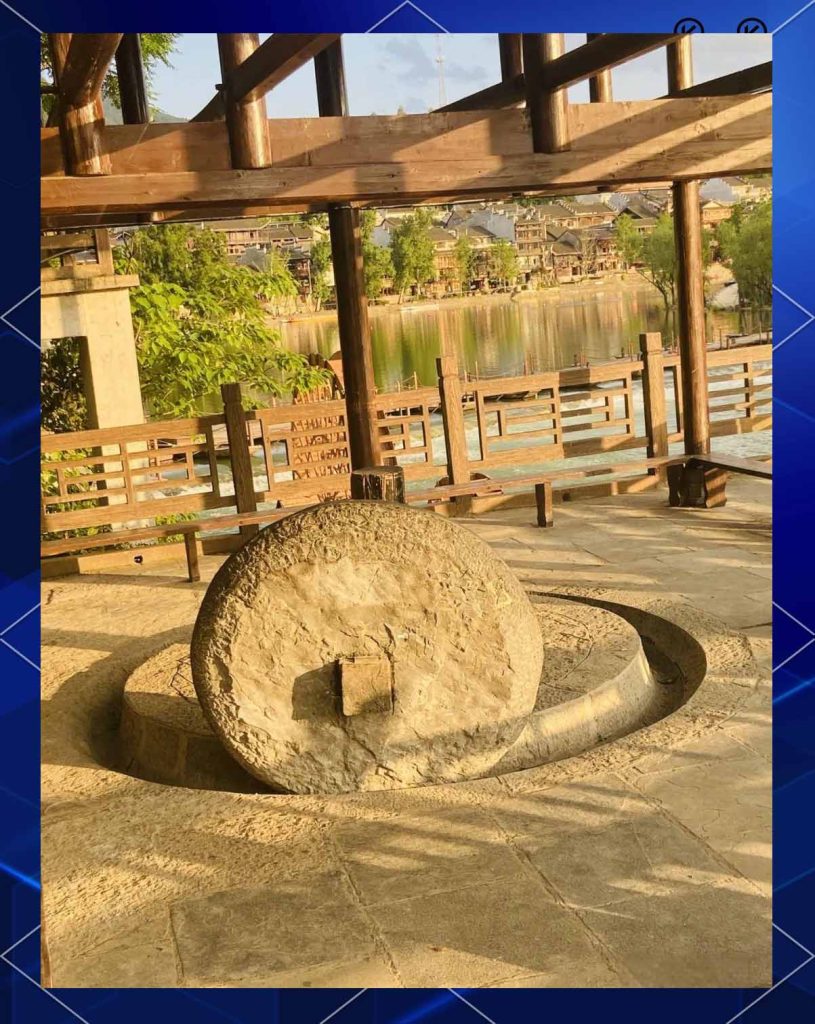
- The bronze statue of Shen Congwen and the exhibition hallof ‘Border City’: On the central square of the ancient town, there is a bronze statue of Mr. Shen Congwen. Sitting on a stone stool, he looked at the clear water River, as if he was still staring at the land he loved so much. Land. In the ‘Border City’ exhibition Hall next to it, Shen Congwen’s manuscripts, different versions of ‘Border City’, and historical photos of Cha Dong are displayed, which can give you a deeper understanding of the relationship between the novel and Cha Dong.
3. Watch a live performance of ‘Border City’: feel the charm of the story in an immersive way
If you want to experience the story of ‘Border City’ more intuitively, don’t miss the real performance of ‘Border City’ at Tea House. The performance takes the Qingshuijiang River as the stage, with the hanging foot Tower and the white Tower as the background, the local villagers play the roles of ”Cuicui“, ”Grandpa“, ”Nuo Send“ and so on, presenting the plots of ”encounter“, ”Waiting“ and ”parting’ in the novel one by one.
The performance began in the evening. When the sunset set and the lights turned on, the river surface became a natural curtain. The singing of the actors was intertwined with the sound of the river flowing, as if the story of “Border City” was ‘resurrected’ in front of you. Especially in the clip of ‘Cuicui Waiting for Nuo to send’, the actor’s eyes are full of expectation and tenderness, which makes people think of Shen Congwen’s regret and poetry that “this person may never come back, maybe ‘tomorrow’ will come back”.
3. Around the Tea Palace: Unlocking the niche scenery of the ‘junction of the three provinces”
Chadong is located at the junction of Hunan, Guizhou and Chongqing provinces. In addition to the ancient town itself, the surrounding niche attractions are also worth a visit, especially for people who like to travel slowly.
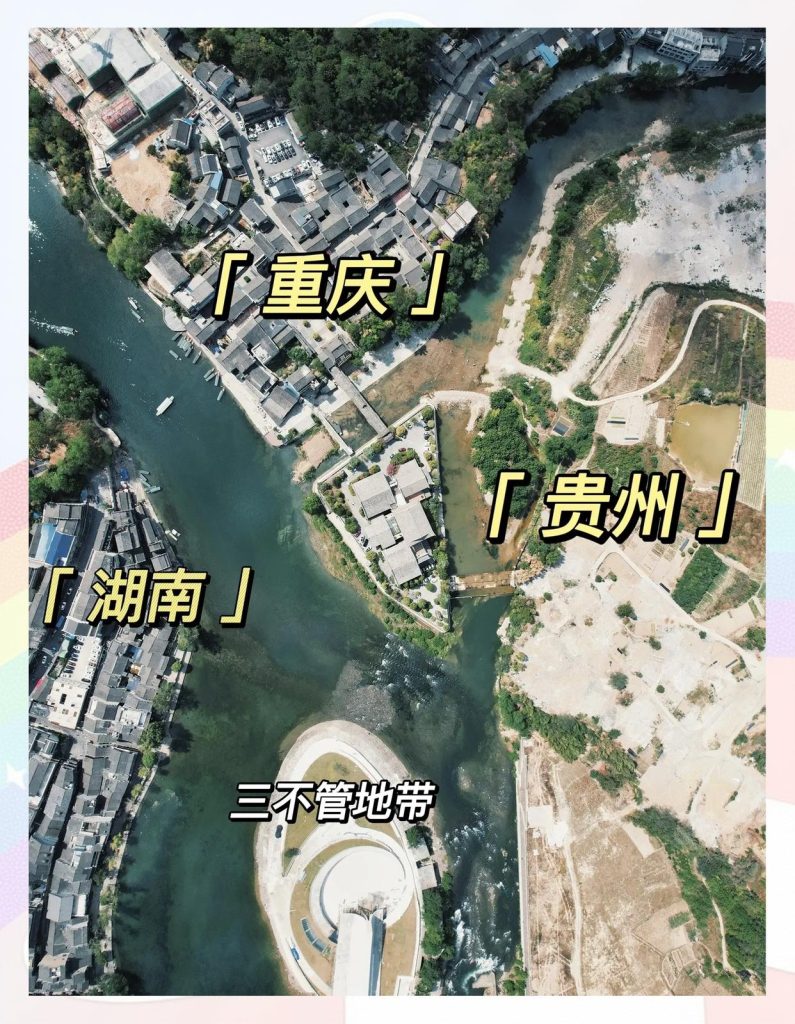
1. Hong’an Ancient Town, Chongqing: Step into the ‘Border City of Chongqing”
From Chadong, take the Lala Ferry to the other side, which is the ancient town of Hong’an in Chongqing. This ancient town is across the river from Cha Dong, but the style is slightly different-Hong’an’s hanging foot building is more atmospheric, and the old shops on the street retain the “rivers and lakes’ of celebration. For example, in the old teahouse, locals sit on bamboo chairs drinking tea, chatting, and posing. “Longmen Array”, full of fireworks.
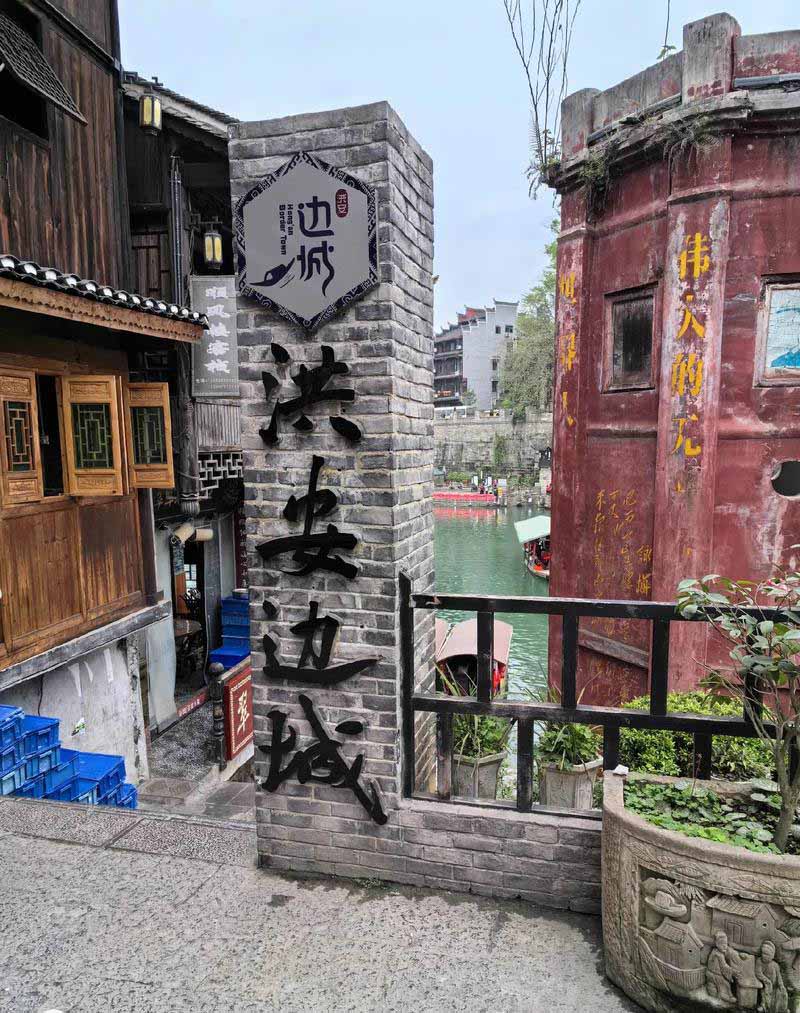
In Hong’an, it is recommended to go to the ”Former site of Liu Deng’s Army’s march to the Great Southwest Command’ to learn about the red history of the ancient town; you can also take a walk along the riverside trail to see the ancient towns of the two provinces across the river, and feel the unique experience of “two provinces with one foot”.
2. Guiqi Town, Guizhou: Feel the Ethnic Minority Customs of Guizhou
From Chadong, it takes about 20 minutes by car to reach Chuanji Town in Guizhou. This is a settlement of the Miao and Tujia ethnic groups, retaining a rich ethnic minority style. If you catch up with the Miao people’s ‘Autumn Festival’ or the Tujia people’s ‘Sheba Festival’, you can also see locals dancing and singing folk songs, and experience lively folk activities.
The natural scenery of Guanchai Town is also very charming. It is surrounded by green mountains and gurgling streams. It is suitable for hiking or cycling to feel the tranquility and simplicity of the Guizhou countryside.
Fourth, a practical guide to tea party travel: Make your journey smoother
1. Transportation: How to get to the tea house?
Chadong is locatedin Huayuan County, Xiangxi Prefecture, Hunan Province, about 120 kilometers from Jishou, the capital of Xiangxi Prefecture, and about 200 kilometers from Zhangjiajie.
- By car: The most recommended way is to depart from Jishou, take the Hangrui Expressway to Zhanghua Expressway, and then take National Highway 209, which can be reached in about 2.5 hours; from Zhangjiajie, take the Zhanghua Expressway, which can be reached in about 3 hours. There is a parking lot in the ancient town, which is convenient for parking.
- Publictransportation: Take the shuttle bus to Huayuan County from Jishou North Bus Station. After arriving in Huayuan County, transfer to the shuttle bus to Chadong, which can be reached in about 1 hour.
2. Accommodation: Where is there more atmosphere to live?
The accommodation in Chadong is mainly bed and breakfast and inns. Most of them are concentrated in the ancient town or by the Qingshui River. It is recommended to choose the ‘Hanging Foot Building Bed and Breakfast’ to experience the architectural characteristics of Western Hunan and enjoy the river view.
- Jiangbian Hanging Foot Building Homestay: For example, “Biancheng Inn” and “Cuicuijia Homestay”, you can see the Qingshui River and Lala Crossing by pushing the window, and you can fall asleep listening to the sound of the river at night. The atmosphere is excellent.
- Innsin the ancient town: For example, the ”Shencongwen Bookstore Inn’ is located in the center of the ancient town, within walking distance of attractions such as the White Tower and the exhibition Hall. There are many snack bars around, making life convenient.
3. Food: The unmissable taste of Western Hunan
The cuisine of Chajiang combines the characteristics of Hunan, Guizhou and Chongqing. The taste is sour and spicy. It is recommended to try these local characteristics.:
- Biancheng rice noodles: Made from local rice, it has a strong taste. There are two kinds of soups, hot and sour, and clear soup. It is paired with toppings such as beef and sausage. It warms the stomach and satisfies the stomach in a bowl.
- Sour soup fish: Use the sour soup of Xiangxi to cook the local rice field fish. The fish is tender and the sour soup is appetizing. It is a signature dish of local hospitality.
- Artemisia seed baba: It is made from glutinous rice and artemisia seed leaves. There are two kinds of sweet (bean paste) and salty (bacon) filling. After steaming, it has a tangy aroma. It is a traditional snack in western Hunan.
- Rice tofu: Made from rice milled pulp, it has a Q-bomb taste. It is paired with spices such as chili, vinegar, and minced garlic. It is spicy and sour and refreshing. It is an artifact for relieving heat in summer.
4. Best time to travel: When is the best time to go?
The four seasons of tea island have different beauties, but the best time to travel isApril-May andSeptember-October.:
- April-May: Tea time in spring, green mountains and green waters, wildflowers are in full bloom, and the mist on the river is filled with mist, like a smart landscape painting, suitable for outing and taking pictures.
- September-October: Autumn tea time, the weather is cool, the rice fields are golden, the osmanthus flowers in the ancient town are blooming, and the air is full of osmanthus fragrance, which is suitable for walking and watching performances.
Avoid going in summer (July-August), when the weather is hot and heavy rains may be encountered; winter (December-February) is colder, and some b&bs may not be open for air conditioning, and the experience will be slightly worse.
5. Written at the end: in the tea room, I met Shen Congwen’s ‘Beauty of human nature”
Some people say, “Reading ‘Border City’ is not as good as going to Chadong, and only when you go to Chadong will you know the meaning of ”Border City’.’ In the days of Cha Dong, there was no hustle and bustle of the city, only the sound of the river flowing, the shouts of the people, and the laughter of the locals. Everything here is very slow-slow enough that you can sit on the Lala crossing and watch the clouds rolling in the clouds, slow enough that you can wander aimlessly on the bluestone road of the ancient town.Wander around so slowly that you can talk to the innkeeper about Shen Congwen’s story all night.
Shen Congwen once said, “I just want to build a small Greek temple. Choose the mountain as the foundation and pile it up with hard stones. Exquisite, strong, and well-proportioned, although the body is small but not delicate, it is my ideal building. This temple enshrines human nature. ‘And the tea palace is the realistic portrayal of this “temple of human nature”-here, you can feel the most simple human feelings, the purest scenery, and the eternal theme of “Beauty and love” written by Shen Congwen.
If you also like Shen Congwen, and if you also yearn for the poetry in ‘Border City’, you might as well pack your bags and go for a walk in the tea Cave-take a Lala crossing, climb the white Tower, watch a performance of ‘Border City’, and meet the ‘Cuicui’ in the hanging Foot Building by the Qingshui River.”As pure as Xiangxi.
If you want to continue to explore more attractive places, our team of professional travel consultants can serve you. The consultants are familiar with the attractions, terroir and popular routes in various regions of the mainland, and can tailor exclusive trips according to your preferences, budget and time, so that the journey is full of surprises.
Don’t hesitate, contact our travel consultant!


Contact information



